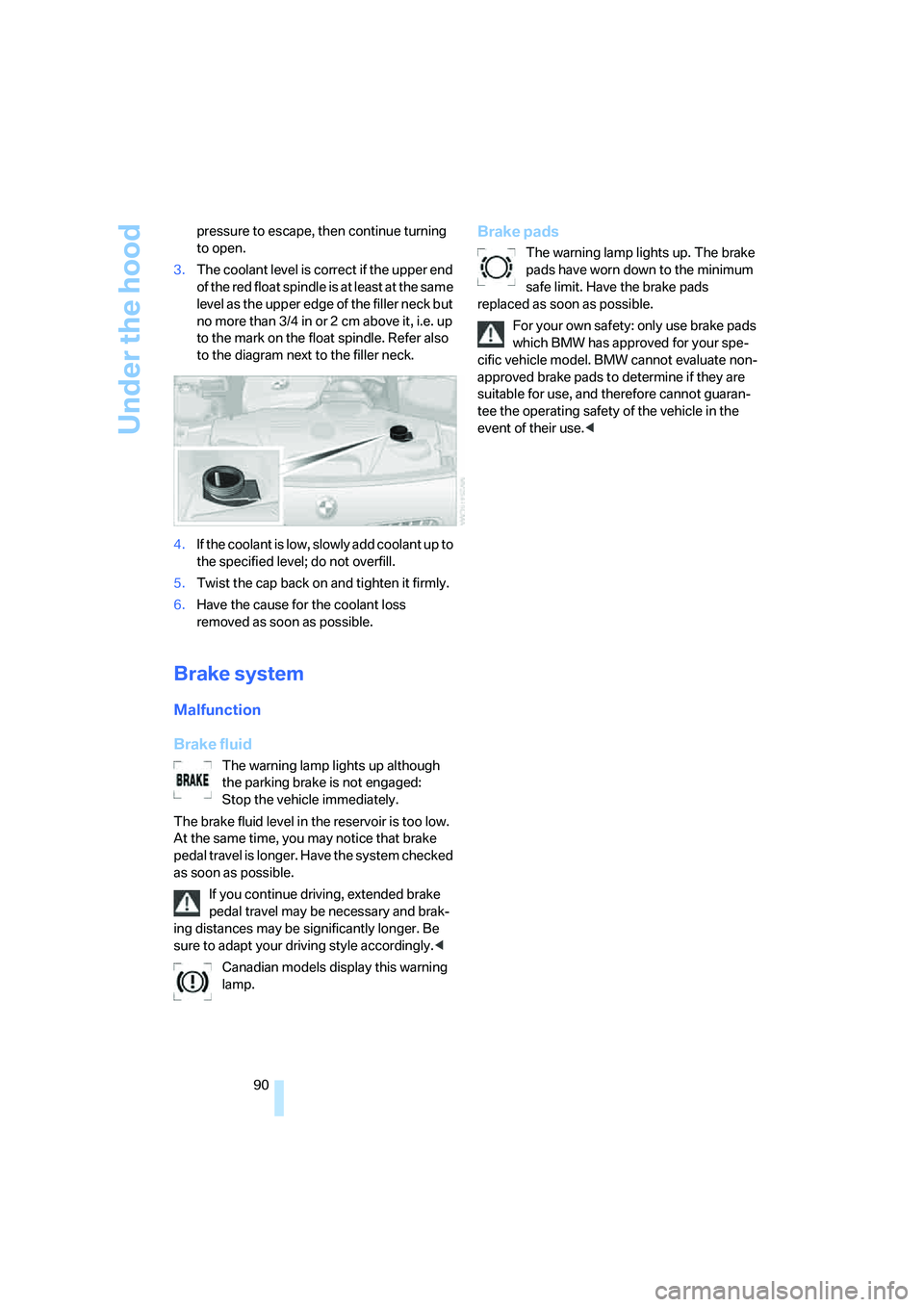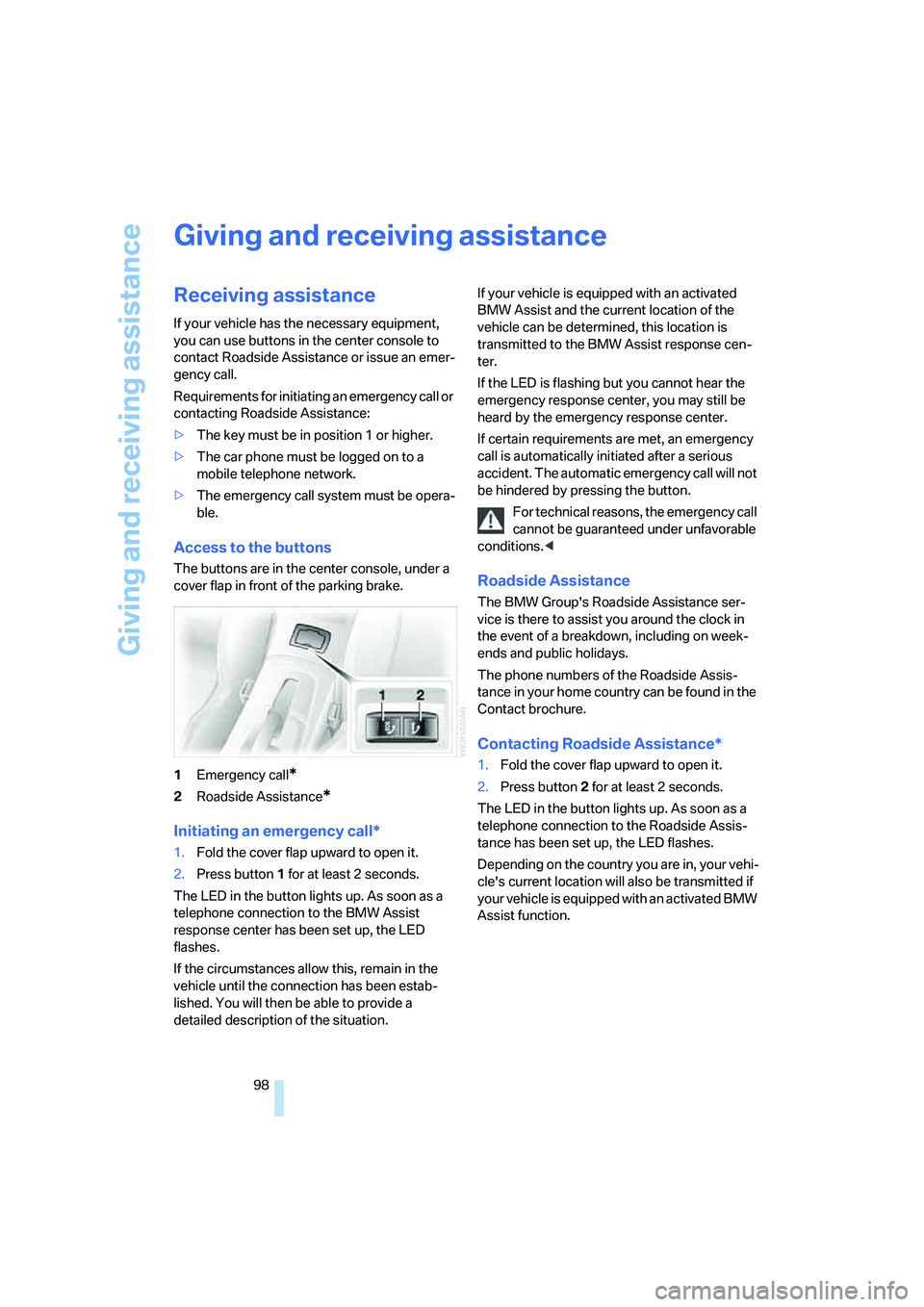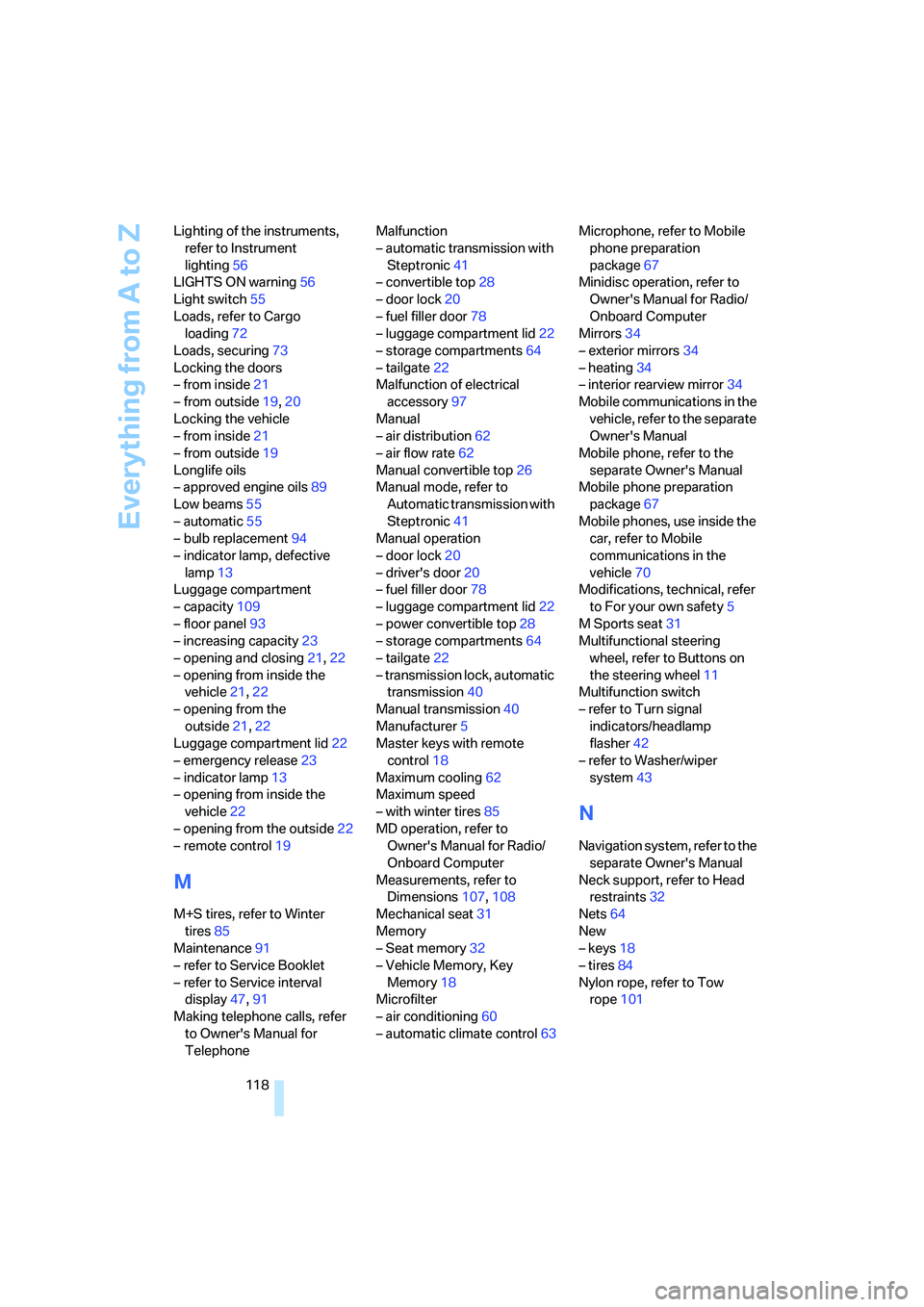2006 BMW Z4 3.0SI ROADSTER lights
[x] Cancel search: lightsPage 91 of 128

Reference
At a glance
Controls
Driving tips
Mobility
89
Adding engine oil
Do not add the maximum amount of 1 US quart/
1 liter of engine oil until the warning lamp lights
up in the instrument cluster, refer to page87, or
until the oil level monitor shows "+1.0".
Add oil within the next 125 miles/200 km,
otherwise the engine could be dam-
aged.<
Keep oils, greases, etc. out of the reach of
children and comply with the warnings on
the containers. Otherwise, health hazards may
result.<
Oil change
Have your oil changed only by a BMW Center or
a workshop that works according to BMW
requirements with the appropriately trained
personnel.
Approved engine oils
The quality of the engine oil is extremely impor-
tant for the function and life of an engine. BMW
continuously approves specific oils after con-
firming their suitability for use in its vehicles
with extensive testing.
Only use approved BMW High Performance
Synthetic Oil.
If BMW High Performance Synthetic Oil is not
available, you can add small quantities of other
synthetic oils in between oil changes. Only use
oils with the API SH specification or higher.
Your BMW Center will be glad to answer
any questions regarding BMW High Per-
formance Synthetic Oil or other approved syn-
thetic oils.
www.bmwusa.com to obtain this information.
Do not use any oil additives, as they could
cause engine damage under some cir-
cumstances.<
Viscosity classes
Viscosity is a measure of an oil's flow rating and
is categorized in SAE classes.
Selecting the appropriate SAE class depends
on the regional climatic conditions in which you
normally drive your BMW.
Approved oils belong to the 5W-40 and
5W-30 classes.<
These oils can be used for driving at all outside
temperatures.
Coolant
Warning lamp
The warning lamp lights up:
The coolant level is too low. Top up the
coolant as soon as possible.
Do not open the cooling system when the
engine is hot. If you do, escaping coolant
can cause burns.<
Coolant consists of water and coolant additives.
Not all commercially available additives are suit-
able for your BMW. Your BMW Center knows
which additives are appropriate.
Only use approved additives, otherwise
the engine could be damaged. The addi-
tives are hazardous to health.<
Comply with the appropriate environ-
mental protection regulations when dis-
posing of coolant additives.<
Checking the coolant level
1.The engine must be at ambient tempera-
ture.
2.Turn the cap of the expansion tank a little
counterclockwise to allow any accumulated
Page 92 of 128

Under the hood
90 pressure to escape, then continue turning
to open.
3.The coolant level is correct if the upper end
of the red float spindle is at least at the same
level as the upper edge of the filler neck but
no more than 3/4 in or 2 cm above it, i.e. up
to the mark on the float spindle. Refer also
to the diagram next to the filler neck.
4.If the coolant is low, slowly add coolant up to
the specified level; do not overfill.
5.Twist the cap back on and tighten it firmly.
6.Have the cause for the coolant loss
removed as soon as possible.
Brake system
Malfunction
Brake fluid
The warning lamp lights up although
the parking brake is not engaged:
Stop the vehicle immediately.
The brake fluid level in the reservoir is too low.
At the same time, you may notice that brake
pedal travel is longer. Have the system checked
as soon as possible.
If you continue driving, extended brake
pedal travel may be necessary and brak-
ing distances may be significantly longer. Be
sure to adapt your driving style accordingly.<
Canadian models display this warning
lamp.
Brake pads
The warning lamp lights up. The brake
pads have worn down to the minimum
safe limit. Have the brake pads
replaced as soon as possible.
For your own safety: only use brake pads
which BMW has approved for your spe-
cific vehicle model. BMW cannot evaluate non-
approved brake pads to determine if they are
suitable for use, and therefore cannot guaran-
tee the operating safety of the vehicle in the
event of their use.<
Page 94 of 128

Maintenance
92
Exhaust emission values
The warning lamp lights up: the
exhaust emission values have wors-
ened. Have the car checked as soon as
possible.
The lamps flash under certain conditions. This
indicates excessive misfiring of the engine. If
this happens, you should reduce your speed
and visit your nearest BMW Center as soon as
possible. Severe engine misfiring can quickly
lead to serious damage of emissions-related
components, especially the catalytic converter.
Canadian models display this warning
lamp.
If the gas cap is not properly tightened,
the OBD system will assume that fuel
vapor is escaping. An indicator will then light up.
If the cap is then tightened, the indicator will go
out within a few days.<
Event Data Recorders
Your vehicle may be equipped with one or sev-
eral measuring or diagnostic modules or a
device for recording or sending certain vehicle
data or information. In addition, if you have
signed a subscription contract for BMW Assist,
certain vehicle data may be transmitted or
recorded in order to facilitate the corresponding
services.
Care
Important information on the care and mainte-
nance of your BMW is contained in the Caring
for your vehicle brochure.
Page 99 of 128

Reference
At a glance
Controls
Driving tips
Mobility
97
Jacking points
The jacking points are located at the positions
indicated in the illustration.
Vehicle battery
Maintenance
The battery is completely maintenance-free.
This means that the original electrolyte will nor-
mally last for the service life of the battery under
moderate climatic conditions. Your BMW Cen-
ter will be happy to advise you if you have any
questions concerning the battery.
Indicator lamp
The indicator lamp lights up:
The battery is no longer being charged.
The alternator drive belt is defective or
there is a malfunction in the charging circuit of
the alternator. Have the system checked as
soon as possible.
If the drive belt is defective, pull over and
switch off the engine immediately to pre-
vent overheating and serious engine damage.
If the onboard supply voltage drops to a very
low level, increased steering effort may also be
necessary.<
Charging the battery
Charge the battery in the vehicle only when the
engine has been switched off. Connections,
refer to Jump-starting on page99.
Battery disposal
After changing a battery, have the used
battery disposed of by your BMW Center or bring it to a recycling point. Maintain the bat-
tery in an upright position for transport and stor-
age. Secure the battery against tilting when
transporting.<
Power loss
After a temporary power loss, the functioning of
some equipment may be limited and require ini-
tialization. Individual settings are also lost and
must be reset:
>Seat memory
The positions must be stored again, refer to
page32.
>Clock must be reset, refer to page47.
Fuses
Do not attempt to repair a burned fuse or
replace it with a fuse having a different
color or amperage rating. To do this could
cause a fire in the vehicle as a result of circuit
overload.<
You will find the fuses and information on their
respective allocation behind the glove compart-
ment.
1.Open the glove compartment.
2.Press the lock on the left, arrow1.
3.Press the lock on the right, arrow2.
4.Swing the glove compartment down.
Spare fuses and plastic tweezers for grasping
the fuses are found in the onboard tool kit; refer
to page93.
Page 100 of 128

Giving and receiving assistance
98
Giving and receiving assistance
Receiving assistance
If your vehicle has the necessary equipment,
you can use buttons in the center console to
contact Roadside Assistance or issue an emer-
gency call.
Requirements for initiating an emergency call or
contacting Roadside Assistance:
>The key must be in position 1 or higher.
>The car phone must be logged on to a
mobile telephone network.
>The emergency call system must be opera-
ble.
Access to the buttons
The buttons are in the center console, under a
cover flap in front of the parking brake.
1Emergency call
*
2Roadside Assistance*
Initiating an emergency call*
1.Fold the cover flap upward to open it.
2.Press button1 for at least 2 seconds.
The LED in the button lights up. As soon as a
telephone connection to the BMW Assist
response center has been set up, the LED
flashes.
If the circumstances allow this, remain in the
vehicle until the connection has been estab-
lished. You will then be able to provide a
detailed description of the situation.If your vehicle is equipped with an activated
BMW Assist and the current location of the
vehicle can be determined, this location is
transmitted to the BMW Assist response cen-
ter.
If the LED is flashing but you cannot hear the
emergency response center, you may still be
heard by the emergency response center.
If certain requirements are met, an emergency
call is automatically initiated after a serious
accident. The automatic emergency call will not
be hindered by pressing the button.
For technical reasons, the emergency call
cannot be guaranteed under unfavorable
conditions.<
Roadside Assistance
The BMW Group's Roadside Assistance ser-
vice is there to assist you around the clock in
the event of a breakdown, including on week-
ends and public holidays.
The phone numbers of the Roadside Assis-
tance in your home country can be found in the
Contact brochure.
Contacting Roadside Assistance*
1.Fold the cover flap upward to open it.
2.Press button2 for at least 2 seconds.
The LED in the button lights up. As soon as a
telephone connection to the Roadside Assis-
tance has been set up, the LED flashes.
Depending on the country you are in, your vehi-
cle's current location will also be transmitted if
your vehicle is equipped with an activated BMW
Assist function.
Page 120 of 128

Everything from A to Z
118 Lighting of the instruments,
refer to Instrument
lighting56
LIGHTS ON warning56
Light switch55
Loads, refer to Cargo
loading72
Loads, securing73
Locking the doors
– from inside21
– from outside19,20
Locking the vehicle
– from inside21
– from outside19
Longlife oils
– approved engine oils89
Low beams55
– automatic55
– bulb replacement94
– indicator lamp, defective
lamp13
Luggage compartment
– capacity109
– floor panel93
– increasing capacity23
– opening and closing21,22
– opening from inside the
vehicle21,22
– opening from the
outside21,22
Luggage compartment lid22
– emergency release23
– indicator lamp13
– opening from inside the
vehicle22
– opening from the outside22
– remote control19
M
M+S tires, refer to Winter
tires85
Maintenance91
– refer to Service Booklet
– refer to Service interval
display47,91
Making telephone calls, refer
to Owner's Manual for
TelephoneMalfunction
– automatic transmission with
Steptronic41
– convertible top28
– door lock20
– fuel filler door78
– luggage compartment lid22
– storage compartments64
– tailgate22
Malfunction of electrical
accessory97
Manual
– air distribution62
– air flow rate62
Manual convertible top26
Manual mode, refer to
Automatic transmission with
Steptronic41
Manual operation
– door lock20
– driver's door20
– fuel filler door78
– luggage compartment lid22
– power convertible top28
– storage compartments64
– tailgate22
– transmission lock, automatic
transmission40
Manual transmission40
Manufacturer5
Master keys with remote
control18
Maximum cooling62
Maximum speed
– with winter tires85
MD operation, refer to
Owner's Manual for Radio/
Onboard Computer
Measurements, refer to
Dimensions107,108
Mechanical seat31
Memory
– Seat memory32
– Vehicle Memory, Key
Memory18
Microfilter
– air conditioning60
– automatic climate control63Microphone, refer to Mobile
phone preparation
package67
Minidisc operation, refer to
Owner's Manual for Radio/
Onboard Computer
Mirrors34
– exterior mirrors
34
– heating34
– interior rearview mirror34
Mobile communications in the
vehicle, refer to the separate
Owner's Manual
Mobile phone, refer to the
separate Owner's Manual
Mobile phone preparation
package67
Mobile phones, use inside the
car, refer to Mobile
communications in the
vehicle70
Modifications, technical, refer
to For your own safety5
M Sports seat31
Multifunctional steering
wheel, refer to Buttons on
the steering wheel11
Multifunction switch
– refer to Turn signal
indicators/headlamp
flasher42
– refer to Washer/wiper
system43
N
Navigation system, refer to the
separate Owner's Manual
Neck support, refer to Head
restraints32
Nets64
New
– keys18
– tires84
Nylon rope, refer to Tow
rope101
Page 123 of 128

Reference
At a glance
Controls
Driving tips
Mobility
121
Starting assistance, refer to
Dynamic Stability Control
DSC49
Starting difficulties
– jump-starting99
– temperature39
Starting with a flat battery,
refer to Jump-starting99
Status of this Owner's Manual
at time of printing5
Steering wheel10
– adjusting34
– buttons on steering
wheel11
– lock38
Steptronic, refer to Sport
program and Manual
operation41
Storage compartments64
– electrical fault64
– eyeglasses compartment65
– glove compartment64
– opening manually64
Storage nets64
Storage space, refer to
– Cargo bay23
Storage space, refer to
Storage compartments64
Storing seat position, refer to
Seat memory32
Stowage, refer to Storage
compartments64
Summer tires, refer to Wheels
and tires80
Supply reservoir, refer to
Washer fluid reservoir44
Switches, refer to Cockpit10
Switch for passenger
airbags35
Switching cooling function on/
off manually59,62
Symbols4
T
Table of contents3
Tachometer46Tailgate21
– emergency operation22
– opening from inside the
vehicle21
– opening from the outside21
– opening manually22
– remote control19
– roller-blind cover65
Tail lamps, refer to Rear
lamps96
Tail lights, refer to Rear
lamps96
Tank contents
– refer to Capacities110
Tank indicator, refer to Fuel
gauge46
Technical data106
Technical modifications, refer
to For your own safety5
Telephone, refer to the
separate Owner's Manual
Telephone preparation
package67
Temperature
– air conditioning59
– automatic climate control62
– coolant, refer to Coolant
thermometer47
– engine47
Temperature display
– outside temperature46
– outside temperature
warning46
– setting unit of measure48
Tempomat, refer to Cruise
control44
Third brake lamp, refer to
Center high-mount brake
lamp96
Three-point safety belt, refer
to Safety belts33
Tilt alarm sensor25
Tilt function, passenger-side
mirror34
Tire inflation pressure80
– checking80
– loss51
– restoring80
Tire renewal84Tires
– age82,84
– break-in procedures70
– changing84
– coding82
– condition83
– damage84
– DOT quality grades82
– flat
51
– inflation pressure80
– pressure monitoring, refer to
Flat Tire Monitor51
– replacement84
– size80
– storage85
– temperature83
– traction83
– tread83
– tread wear83
– Uniform Tire Quality
Grading82
– wear indicators, refer to
Minimum tread depth83
– wheel and tire
replacement84
– winter tires85
– with emergency features,
refer to Run-Flat Tires84
Tire storage85
Tool kit, refer to Onboard tool
kit93
Torque, refer to Engine
data106
Tow bar101
Towing eyelet100
Towing the vehicle100
– methods101
– with automatic
transmission101
Tow rope101
Tow-starting101
Tow truck101
Track width, refer to
Dimensions107,108
Traction control, refer to
Dynamic Stability Control
DSC49